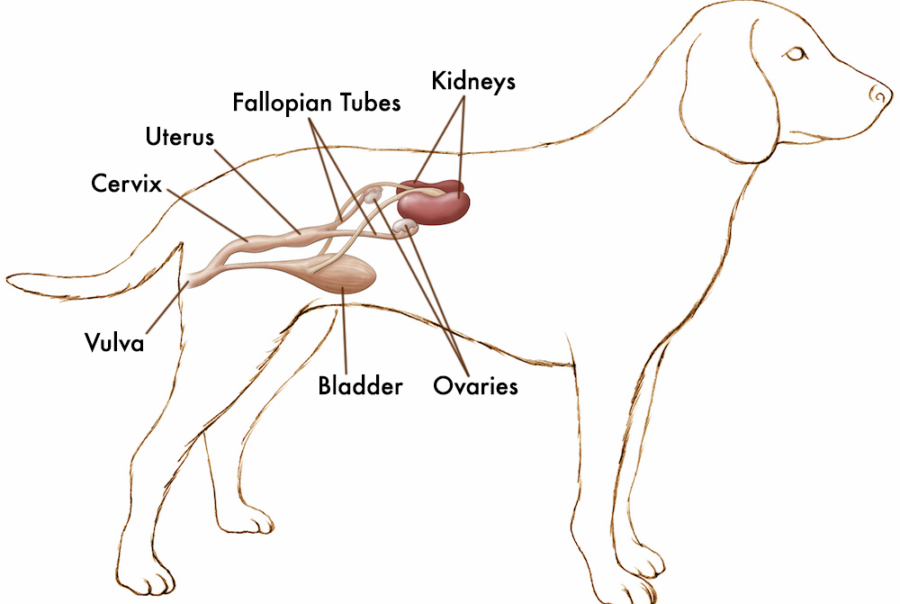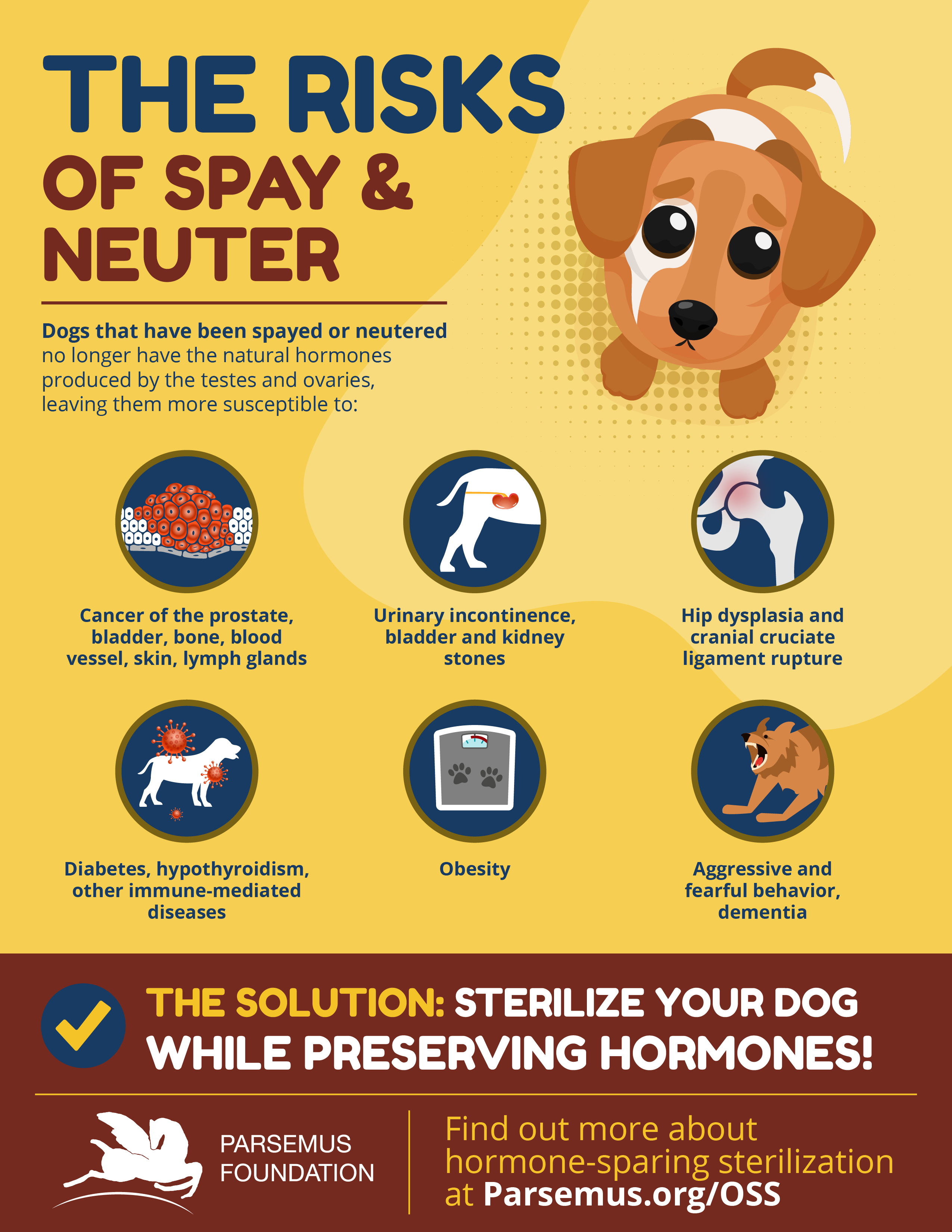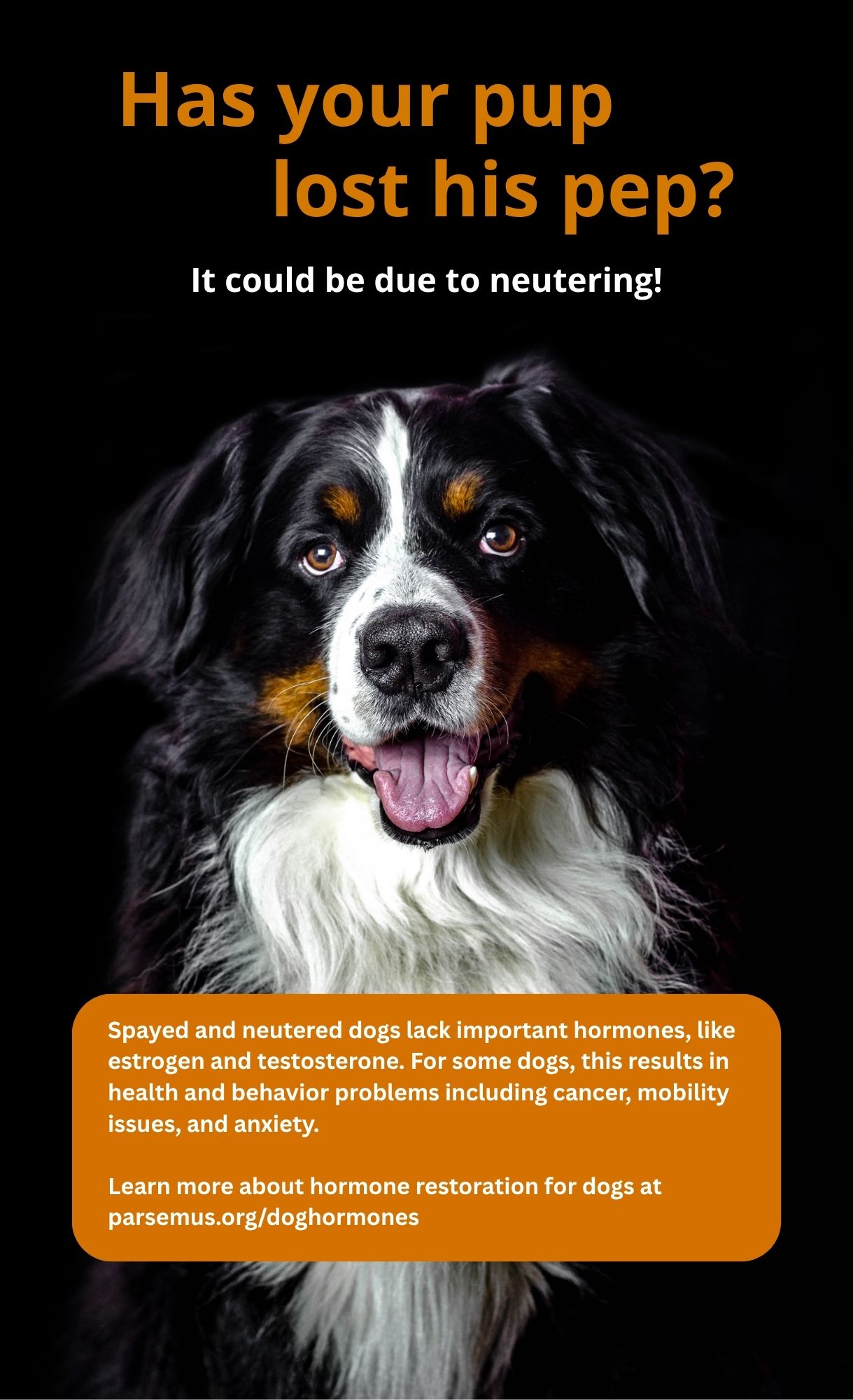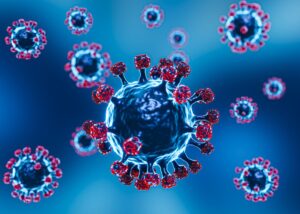PROJECT
Hormone Restoration
in Dogs
PET HEALTH
PROJECT
Hormone Restoration
in Dogs
PET HEALTH
Project summary
Background
- In the U.S. and many other countries, spay and neuter has become standard practice for pet population control and is completed by removal of the sex organs — the ovaries and uterus in females (ovariohysterectomy) and the testes in males (orchiectomy/castration).
- After several decades of widespread spay/neuter practice, research in dogs has found that removal of the sex organs and associated hormones can result in significant health issues for some pets, including cancers and joint disorders.
Key points
- Hormone restoration therapy for dogs aims to rebalance hormones lost through spay or neuter surgery. Initial reports provide positive outcomes for replacing testosterone and balancing luteinizing hormone in male dogs with behavior and physical issues.
- Hormone restoration is a new treatment area in dogs, with little scientific evaluation. A recent study of weekly testosterone treatment in neutered dogs was found to be safe and effective at raising testosterone levels.
- This webpage provides updated information on this evolving topic.
Parsemus' role
- The Parsemus Foundation was an early proponent of individualizing pet sterilization and has served as a repository of information on hormone-sparing sterilization options.
- The first case study of hormone restoration in a castrated dog was published by the Parsemus Foundation.
- The foundation is helping to develop standardized methods of hormone restoration in dogs, providing resources for both pet owners and veterinary practitioners, and maintaining a veterinary directory of providers for alternative sterilization methods and hormone restoration.
Topics
- Hormone loss from spay and neuter: An underappreciated reason for health problems in dogs
- Hormone restoration for dogs that may be suffering from a lack of natural hormones
- Case study on hormone restoration in a neutered dog
- From our team: The dog behind the study
- Target safety study of testosterone for neutered dogs
- A call for more research
- Take action on hormone restoration
- Veterinarians offering alternative methods of contraception
- Additional resources
Other pet health projects
Hormone loss from spay and neuter: An underappreciated reason for health problems in dogs
Gonadectomy and hormone loss
Over 80% of dogs in the U.S. have had a spay or neuter, which removes the sex organs (called gonadectomy) and associated hormones. About 15 years ago, veterinarians and researchers started to realize that spayed or neutered dogs were more likely to have certain health problems, such as cancer and joint disorders. The amount of research has increased over the years and indicates that a loss of natural hormones can have significant lifelong health implications. For a thorough review of the data on gonadectomy and canine health, see our Hormone-Sparing Sterilization page.
You may expect that a loss of sex hormones would only be related to reproduction. Yet a growing body of research indicates that serious health complications unrelated to the sex organs may occur after spay/neuter. Obesity, urinary incontinence, various cancers, immune-mediated diseases, musculoskeletal disorders, and cognitive and behavior problems are more common in gonadectomized dogs. These diverse symptoms related to the loss of natural hormones have been termed “spay-neuter syndrome.”
These health problems likely occur because the natural hormone feedback mechanisms become unregulated in neutered dogs. Research from Dr. Michelle Kutzler of Oregon State University, a veterinary theriogenologist and pioneer in understanding the mechanisms of hormone loss in dogs, indicates that luteinizing hormone (LH) may be the problem. In dogs without natural hormone levels, there is no feedback mechanism to control LH. LH affects many organs throughout the body, and the high levels of unopposed LH likely influence the development of diverse health disorders. These findings underscore the importance of a balanced hormonal system for maintaining optimal health.
Gonadectomy has several positive health outcomes and helps reduce pet overpopulation. Gonadectomized dogs are not as likely to have diseases associated with sex organs, such as mammary, ovarian, and testicular cancers, pyometra uterine infection, and prostate enlargement. Not all dogs will develop health problems after being spayed or neutered. A complex set of variables appears to influence the importance of sex hormones, including the age of the dog when spayed or neutered, the breed, the sex of the dog, and its size. Health issues are common in dogs that undergo spaying or neutering at a young age, as well as in large breed dogs that undergo this procedure before they have finished growing.
To avoid potential health and behavior issues related to spay and neuter, pet owners can choose a hormone-sparing sterilization method, such as vasectomy for males and hysterectomy (also called ovary-sparing spay) for females. For more information, see details on our Hormone-Sparing Sterilization page.
Hormone restoration for dogs that may be suffering from a lack of natural hormones
Most dogs have already received a traditional spay or neuter surgery, removing the ovaries or testes. In fact, pet shelters or rescue organizations usually require that dogs and cats are spayed or neutered before adoption. Some of these pets will develop health or behavior issues due to the loss of natural hormones, or spay-neuter syndrome.
In humans, a loss of hormones due to injury or disease would be treated by hormone therapy to maintain health. This includes treatment with estrogen, testosterone, or other hormones. Couldn’t we supplement the lost hormones in spayed or neutered dogs to treat or prevent health conditions?
While restoring normal hormone levels in spayed and neutered dogs seems like a logical treatment option, it is not a standard veterinary treatment. Very little research has been conducted on this topic.
Most published research in dogs is related to urinary incontinence. This is a common problem in female dogs after being spayed, especially large breeds and those spayed at an early age. Incontinence in females has been treated successfully with various estrogens and gonadotropin-releasing hormone (GnRH) agonists (e.g., deslorelin), and GnRH immunization. These treatments restore urinary continence by reducing luteinizing hormone (LH) concentrations.
One publication in eight male dogs reported treating urinary incontinence with testosterone cypionate (median dose of 1.5 mg/kg intramuscularly every 4 weeks). The treatment worked well for two dogs but was not effective in half of the dogs. However the treatment was considered safe. Other treatments for male dog incontinence include phenylpropanolamine (PPA), estrogens, surgery and anticholinergic drugs. Studies are usually small and medical therapy has not been very effective.
Case study on hormone restoration in a neutered dog
Research on restoring natural hormone levels in dogs after spay or neuter is generally lacking. But a recent case report provides a bit of guidance. Published in Topics in Companion Animal Medicine, this study reviewed the use of hormone restoration therapy in a neutered male dog that had significant health issues shortly after gonadectomy received at seven months of age. Weight gain, loss of mobility due to pain in the right hip, and debilitating fear of strangers significantly reduced the dog’s quality of life.
After three years of standard medical treatments with no significant improvement, hormone restoration was attempted when the dog was about 4 years old. Low testosterone was increased with injectable testosterone cypionate and a weekly subcutaneous dose (0.5 mg/kg) was found to provide a steadier level than a monthly dose. But this dog also had extremely high luteinizing hormone (LH) levels that did not come down to the normal range with testosterone alone. The use of a gonadotropin-releasing hormone agonist implant (deslorelin) effectively reduced LH levels.
Within months, this treatment resulted in improved mobility, stabilized weight, and a reduction in fear and anxiety. The dog could run, jump, and visit public parks — things he could not do previously without pain or extreme anxiety. He also accepted the weekly injections happily, thanks to positive reinforcement training.
“The Parsemus Foundation is often contacted by concerned pet owners seeking to get hormone therapy for their dog. They are often surprised to find that the dog featured in the case study is actually my own pet, Toby. Toby was adopted from a county shelter at 7 months of age and was mandatorily neutered. He showed signs of serious health problems shortly after. As an animal welfare scientist, I knew that his ailments might be due to loss of hormones from being neutered. We now call this ‘spay-neuter syndrome.’ I researched hormone treatments and worked with Dr. Michelle Kutzler to develop a plan.
I’m thrilled that the hormone restoration treatment was successful! Toby has now been on the treatment for 5 years. His mobility problems were totally solved, and while he is still shy around strangers, his anxious behavior is manageable.”
Linda Brent, PhD
Executive Director of the Parsemus Foundation
Target safety study of tesosterone for neutered dogs
A new study published in BMC Veterinary Research is a major advancement in our understanding of hormone therapy for neutered male dogs. Funded by the Parsemus Foundation, this was the first study to provide essential safety and dosing data for injectable testosterone in castrated male dogs. The goal was to give veterinarians clear guidance on safe dosages and monitoring parameters so they can better address hormonal imbalances that contribute to chronic health problems and diminished quality of life.
The 90-day target animal safety study enrolled twelve neutered male dogs divided into four groups, each receiving a different weekly dose of injectable testosterone cypionate: 0x, 1x, 3x, or 5x the standard 0.5 mg/kg dose. Researchers monitored bloodwork, hormone levels, prostate health, behavior, and body condition.
Key findings of the study
- Safety: Testosterone therapy over a three-month period was safe at all tested doses, including up to five times the standard. Most health parameters remained stable, and adverse events were rare and generally unrelated to treatment.
- Hormone Restoration: Testosterone levels measured one week after injection rose in proportion to the dosage, with significantly higher levels in the 3x and 5x groups.
- LH Reduction: Luteinizing hormone (LH), which rises in neutered dogs due to a lack of negative feedback from gonadal hormones, decreased after 90 days of treatment, especially in the 5x group. This is notable because high LH levels have been associated with health risks including cancer.
- Minimal Impacts: Behavioral measures, prostate health scores, body condition scores, clinical evaluations, and routine bloodwork showed only minor variations across groups or over time, indicating overall stability during treatment.
Testosterone levels in neutered dogs in the study at Day 0 (baseline) and during three months of testosterone therapy at three dose levels (1X, 3X, and 5X the standard dose). Measurements were taken one week following dosing, reflecting the low point in the week.
The paper also discusses risks, offers LH-reduction strategies, and recommends further research to understand testosterone metabolism and long-term outcomes. While the initial results are encouraging, follow-up studies will be essential to confirm ongoing safety and efficacy.
A call for more research
Understanding spay-neuter syndrome after gonadectomy and hormone loss
Take Action on
Hormone Restoration
Key points to keep in mind
- Gonadectomy does not result in health disorders in all dogs, so it is important to work with your veterinarian to rule out other causes if your dog has a health issue.
- The basic protocol for hormone restoration:
- Males: testosterone cypionate injection (weekly 0.5 mg/kg subcutaneously recommended) and Suprelorin (deslorelin acetate) implant to reduce high luteinizing hormone
- Females: Oral estrogen (such as Estriol or diethylstilbestrol) and Suprelorin
(deslorelin acetate) implant to reduce high luteinizing hormone - Ideally, LH levels should be monitored before and after therapy, and testosterone/estrogen levels measured after treatment is initiated. Adjustments to dosing may be necessary.
- Few laboratories in the U.S. run assays for luteinizing hormone. We have used the Colorado State University Veterinary Endocrinology Lab. The luteinizing hormone assay is run in a batch, meaning that 20 or more blood samples will be run at the same time. It is not financially feasible to run small batches and so the availability of testing has been limited. A group of veterinarians is currently working on developing other options for testing LH. Note: Keep in mind that all spayed and neutered dogs are likely to have high LH levels. If you do not have access to LH testing, some veterinarians recommend treatment with Suprelorin anyway, which will reduce LH.
- Keep in mind that dogs on hormone restoration therapy may exhibit behaviors (interest in mating) and health issues (enlarged prostate) that are more common in intact dogs.
For Veterinarians
- If your veterinary clinic offers hormone therapy or alternative sterilization methods, please consider listing in our free directory by filling out the info on the clinic registration form.
- We are seeking veterinarians interested in collaborating on research on the topic of hormone restoration in spayed or neutered dogs. Please contact the Parsemus Foundation at in**@******us.org.
- Check out our Hormone-Sparing Sterilization webpages for much more information the implications of gonadectomy and how to perform vasectomy and hysterectomy (ovary sparing spay). Contact us if you would like to receive more details or to consult with an experienced practitioner.
For Pet Owners
- If you think your dog might be suffering from a loss of hormones, consult a veterinarian who is familiar with the health issues related to spay/neuter, hormone-sparing options, or hormone restoration.
- To find a veterinarian, you can search the Veterinary Directory or check the information at the Dogosterone site (Note: Dogosterone is a program of testosterone treatment and has no affiliation with the Parsemus Foundation).
- If you cannot find a provider nearby, you could pass along the information on this website to your own veterinarian and ask if he or she can provide hormone therapy. Direct him or her to the information on this website and email us at in**@******us.org if additional assistance/advice is required.
- Please let us know if you find a veterinarian who offers hormone therapy and would like to join our directory!
- If you choose to restore your dog’s hormones, remember that your dog may behave like an intact dog. Consider joining this Facebook group: Training and behavioral advice for Intact Dogs.
- And send us an update on your experience if you and your veterinarian decide to try hormone restoration for your dog. We are collecting information to inform the development of this new treatment area.
Veterinarians offering alternative methods of contraception
For Pet Owners
Looking for a veterinarian willing to perform procedures beyond surgical spay or neuter? Browse our directory of qualified veterinary professionals.
Veterinarian
Directory
For Veterinarians
Do you offer alternative methods of contraception like ovary-sparing spay and vasectomy, or hormone restoration? Join our referral directory so new clients can find you.
Additional resources
Publications on hormone restoration in dogs
- Aaron A, Eggleton K, Power C, et al. (1996).Urethral sphincter mechanism incompetence in male dogs: a retrospective analysis of 54 cases. Vet Rec 139(22):542–6. (Abstract).
- Berry SJ, Coffey DS, Strandberg JD, Ewing LL (1986). Effect of age, castration, and testosterone replacement on the development and restoration of canine benign prostatic hyperplasia. Prostate, 9:295-302. (Abstract).
- Brent L, Lissner EA, Kutzler MA (2021). Restoration of reproductive hormone concentrations in a male neutered dog improves health: A case study. Topics in Companion An Med 45:100565. (Free full text).
- Donovan CE, Weston A, Kutzler MA (2013). Gonadotropin-releasing hormone immunization to treat urethral sphincter mechanism incompetence in a bitch that experienced an adverse reaction to phenylpropanolamine. J Vet Sci Med Diagn, 2:3. (Abstract).
- Mandigers RJ, Nell T (2001). Treatment of bitches with acquired urinary incontinence with oestriol. Vet Rec 149:764-767. (Abstract).
- Palerme J-S, Mazepa A, Hutchins RG et al. (2017). Clinical response and side effects associated with testosterone cypionate for urinary incontinence in male dogs. Am Anim Hosp Assoc, 53:285-290. (Full text).
- Veronesi M, Rota A, Battocchio M, et al. (2009). Spaying-related urinary incontinence and oestrogen therapy in the bitch. Acta Vet Hung, 57:171-182. (Abstract).
Resources on hormone restoration in dogs
- Hormone replacement therapy in neutered and spayed dogs by Peter Dobias, DVM, Dr. Dobias Natural Healing, April 2024











